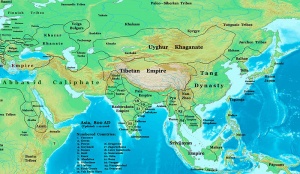Kingdom of Nanzhao
Religion
Nanzhao, alternate spellings Nanchao and Nan Chao (Traditional Chinese: 南詔; Simplified Chinese: 南诏; pinyin: Nánzhào; Standard Tibetan: Jang was a polity that flourished in what is now southern China and Southeast Asia during the 8th and 9th centuries. It was centered around present-day Yunnan in China
Founding and ethnography
Originally, there were several tribes that settled on the fertile land around the alpine fault lake Erhai. These tribes were called Mengshe (蒙舍), Mengsui (蒙嶲), Langqiong (浪穹), Dengtan (邆賧), Shilang (施浪), and Yuexi (越析). Each tribe had its own kingdom, known as a zhao. In 649 AD the chieftain of the Mengshe tribe, Xinuluo (細奴邏), founded a kingdom (Damengguo 大蒙國) in the area of Lake Erhai. In the year 737 AD, with the support of the Tang Dynasty of China, Piluoge (皮羅閣) united the six zhaos in succession, establishing a new kingdom called Nanzhao (Mandarin, "Southern Zhao").
Nanzhao was made up of many ethnic and linguistic groups. Some historians believe that the majority of the population were of the Bai people,[2] but that the elite spoke a variant of Nuosu (also called Yi), a Tibeto-Burman language closely related to Burmese.[3] In any case, the capital was established in 738 at Taihe[disambiguation needed] (modern day Taihe village, a few miles south of Dali). Located in the heart of the Erhai valley, the site was ideal: it could be easily defended against attack, and it was in the midst of rich farmland.
Nanzhao came under Tibetan control from 680 AD. The Tibetans recognised its suzerainty after 703 and then took it under their control again from 750-794, when Nanzhao turned on their Tibetan overlords and helped China defeat their armies.[4]
Nanzhao had a strong connection with Theravada Buddhism[citation needed], as evidenced by surviving stone carvings[citation needed], as well as temples from the period. Some scholars are said to have claimed that Nanzhao's Acarya Buddhism was related to the Tantric Ari Buddhism of Bagan, Myanmar[citation needed].
Expansion
In 750, Nanzhao rebelled against the Tang Dynasty. In retaliation, the Tang sent an army against Nanzhao in 751, but this army was soundly defeated at Xiaguan. (It was in the same year that the Tang suffered another serious defeat at the hands of the Arabs at the Battle of Talas in Central Asia; these defeats weakened the dynasty both internally and externally.) Today the General's Cave (two kilometres west of Xiaguan), and the Tomb of Ten Thousand Soldiers (in Tianbao Park) bear witness to this great massacre. In 754, another Tang army was sent, this time from the north, but it too was defeated (and Tang was unable to send another expedition due to the outbreak of Anshi Rebellion in the following year). Bolstered by these successes, Nanzhao expanded rapidly, first into Burma, then into the rest of Yunnan, down into northern Laos and Thailand, and finally, north into Sichuan. In 829, Chengdu was taken; it was a great prize, as it enabled Nanzhao to lay claim to the whole of Sichuan province, with its rich paddy fields. This was too much for the Tang Dynasty, who lost no time in counterattacking.
Decline
By 873, Nanzhao had been expelled from Sichuan, and retreated back to Yunnan. Taking Chengdu marked the high point of the Nanzhao kingdom, and it was a watershed: from then on, the Nanzhao Kingdom slowly declined.
Overthrow
In 902, the Nanzhao dynasty was overthrown. The end was bloody, for in that year the chief minister murdered all of the key members of the royal family, including the heir apparent. This was followed by three other dynasties in quick succession: Da Changhe, Da Tianxing and Da Yining. Duan Siping seized power in 937 to establish the Kingdom of Dali.
